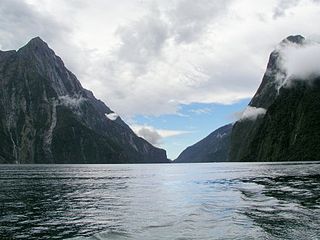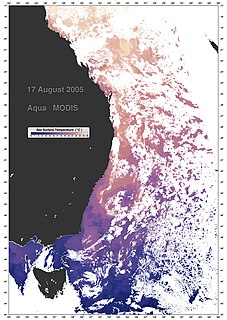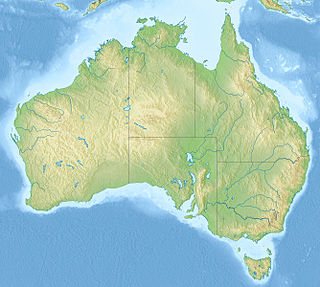| East Gippsland Commonwealth Marine Reserve | |
|---|---|
IUCN category VI (protected area with sustainable use of natural resources) | |
| Map showing the East Gippsland Commonwealth Marine Reserve | |
| Location | Tasman Sea, Australia |
| Nearest town | Mallacoota, Victoria |
| Coordinates | 38°07′S150°20′E / 38.12°S 150.33°E Coordinates: 38°07′S150°20′E / 38.12°S 150.33°E [1] |
| Area | 4,137 km2 (1,597 sq mi) |
| Established | August 31, 2007 |
| Governing body | Parks Australia (Commonwealth of Australia) |
| environment | |
East Gippsland Commonwealth Marine Reserve is a 4,137 km2 marine protected area within Australian waters located in the Tasman Sea near the New South Wales-Victoria border. The reserve was established in 2007 [2] and is part of the South-east Commonwealth Marine Reserve Network.

Marine protected areas (MPA) are protected areas of seas, oceans, estuaries or large lakes. These marine areas can come in many forms ranging from wildlife refuges to research facilities. MPAs restrict human activity for a conservation purpose, typically to protect natural or cultural resources. Such marine resources are protected by local, state, territorial, native, regional, national, or international authorities and differ substantially among and between nations. This variation includes different limitations on development, fishing practices, fishing seasons and catch limits, moorings and bans on removing or disrupting marine life. In some situations, MPAs also provide revenue for countries, potentially equal to the income that they would have if they were to grant companies permissions to fish.

Australia, officially the Commonwealth of Australia, is a sovereign country comprising the mainland of the Australian continent, the island of Tasmania and numerous smaller islands. It is the largest country in Oceania and the world's sixth-largest country by total area. The neighbouring countries are Papua New Guinea, Indonesia and East Timor to the north; the Solomon Islands and Vanuatu to the north-east; and New Zealand to the south-east. The population of 25 million is highly urbanised and heavily concentrated on the eastern seaboard. Australia's capital is Canberra, and its largest city is Sydney. The country's other major metropolitan areas are Melbourne, Brisbane, Perth and Adelaide.

The Tasman Sea is a marginal sea of the South Pacific Ocean, situated between Australia and New Zealand. It measures about 2,000 kilometres (1,200 mi) across and about 2,800 kilometres (1,700 mi) from north to south. The sea was named after the Dutch explorer Abel Janszoon Tasman, who was the first recorded European to encounter New Zealand and Tasmania. The British explorer Captain James Cook later extensively navigated the Tasman Sea in the 1770s as part of his first voyage of exploration.
Contents
The reserve includes both warm and temperate waters, with the East Australian Current bringing subtropical water from the north, forming large eddies around Cape Howe. The complex mix of warmer and cooler waters and the seasonality of currents creates conditions for highly productive phytoplankton growth, which supports an abundance of marine life. [3]

The East Australian Current (EAC) is the southward western boundary current that is formed from the South Equatorial Current (SEC) crossing the Coral Sea and reaching the eastern coast of Australia. At around 15° S near the Australian coast the SEC divides forming the southward flow of the EAC. It is the largest ocean current close to the shores of Australia. The EAC reaches a maximum velocity at 30° S where its flow can reach 90 cm/s. As it flows southward it splits from the coast at around 31° to 32° S. By the time it reaches 33° S it begins to undergo a southward meander while another portion of the transport turns back northward in a tight recirculation. At this location the EAC reaches its maximum transport of nearly 35 Sv. The majority of the EAC flow that does not recirculate will move eastward into the Tasman Front crossing the Tasman Sea just north of the cape of New Zealand. The remaining will flow south on the EAC Extension until it reaches the Antarctic Circumpolar Current. The Tasman Front transport is estimated at 13 Sv. The eastward movement of the EAC through the Tasman Front and reattaching to the coastline of New Zealand forms the East Auckland Current. The EAC also acts to transport tropical marine fauna to habitats in sub-tropical regions along the south east Australian coast.

Cape Howe is a coastal headland in eastern Australia, forming the south-eastern end of the Black-Allan Line, a portion of the border between New South Wales and Victoria. Cape Howe was also the original name of West Cape Howe, a coastal headland near Albany, Western Australia that forms the westernmost extent of the Great Australian Bight.

Phytoplankton are the autotrophic (self-feeding) components of the plankton community and a key part of oceans, seas and freshwater basin ecosystems. The name comes from the Greek words φυτόν (phyton), meaning "plant", and πλαγκτός (planktos), meaning "wanderer" or "drifter". Most phytoplankton are too small to be individually seen with the unaided eye. However, when present in high enough numbers, some varieties may be noticeable as colored patches on the water surface due to the presence of chlorophyll within their cells and accessory pigments in some species.


